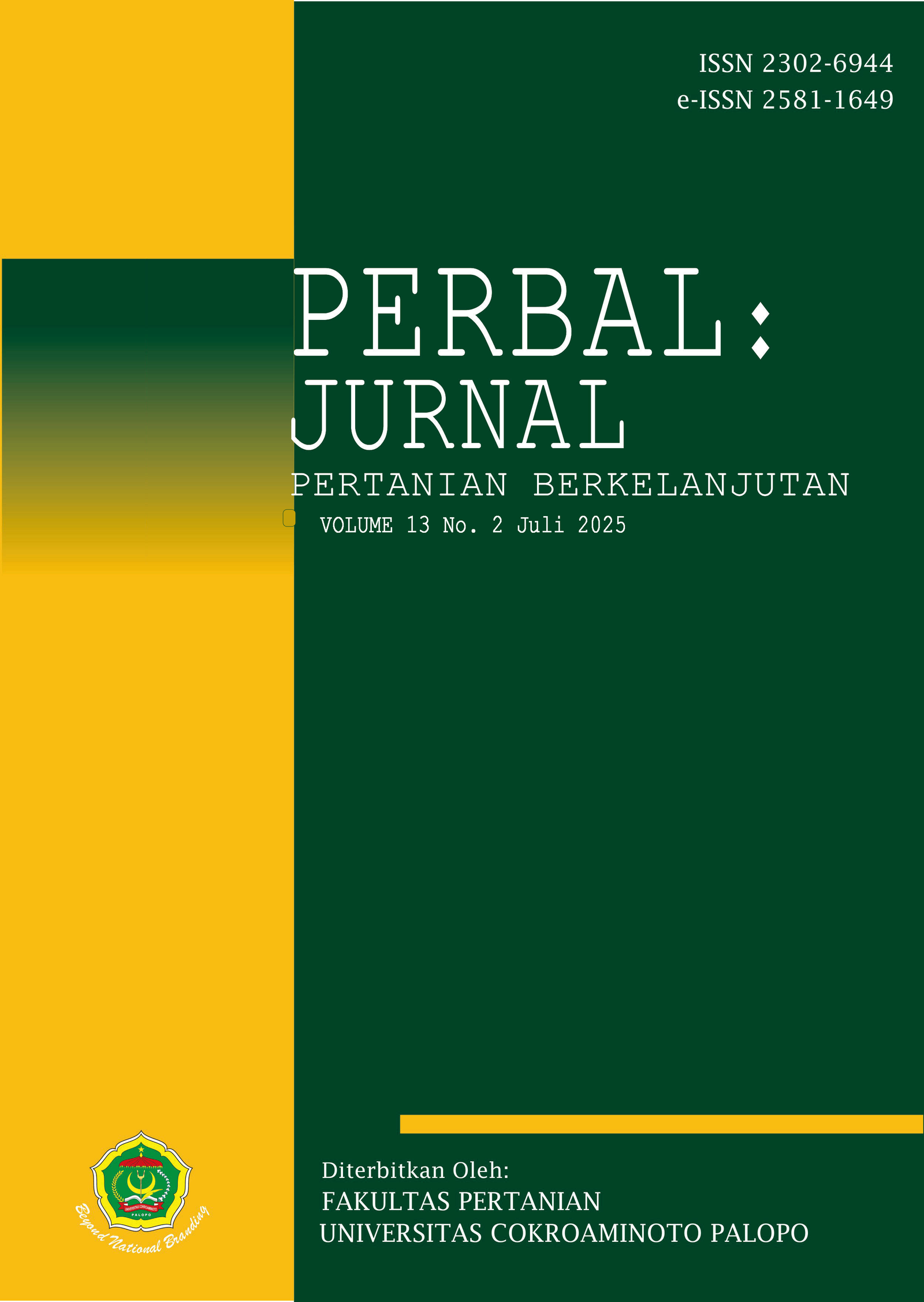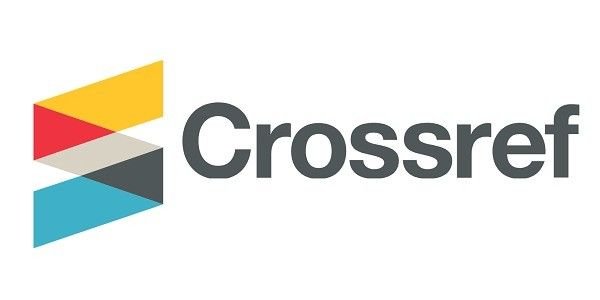Morfologi Cendawan Terbawa Benih Padi Asal Sentra Pertanaman Padi Kalimantan Utara
Morphology of Seed-Borne Fungi From Rice-Growing Centers in North Kalimantan
DOI:
https://doi.org/10.30605/perbal.v13i2.6371Keywords:
Benih padi, Kalimantan Utara, morfologi cendawan, sentra padiAbstract
Cendawan merupakan mikroorganisme eukariotik yang dapat terbawa oleh benih padi dan bersifat patogenik, menurunkan kualitas, daya tumbuh, dan hasil panen. Spora atau hifa cendawan dapat bertahan dalam kondisi dorman pada benih. Identifikasi morfologi seperti warna koloni, hifa, dan konidia penting untuk deteksi awal. Penelitian ini bertujuan mengidentifikasi morfologi cendawan terbawa benih padi di Kalimantan Utara sebagai dasar pengendalian penyakit sejak tahap perbenihan. Penelitian dilakukan di empat kecamatan sentra padi Kalimantan Utara: Tanjung Selor, Tanjung Palas, Tanjung Palas Tengah, dan Tanjung Palas Utara pada tahun 2020 menggunakan metode snowball sampling hingga mencapai 75% petani. Dari tiap responden diambil 200 gram benih padi. Deteksi cendawan menggunakan blotter test dan diinkubasi selama satu minggu. Identifikasi dilakukan dengan mikroskop stereo (400x dan 1000x) berdasarkan hifa dan konidia. Kabupaten Bulungan, Kalimantan Utara, merupakan sentra produksi padi dengan 14 varietas benih yang digunakan petani. Dari sampel benih di empat kecamatan, ditemukan empat genus cendawan, yakni Alternaria, Aspergillus, Mucor, dan Rhizopus. Cendawan tersebut memiliki karakteristik morfologi berbeda dan dapat bersifat patogen maupun bermanfaat.
Fungi are eukaryotic microorganisms that can be seed-borne in rice and act as pathogens, reducing seed quality, germination rate, and yield. Fungal spores or hyphae can remain dormant within seeds. Morphological identification—such as colony color, hyphae, and conidia—is crucial for early detection. This study aims to identify the morphology of seed-borne fungi in rice from North Kalimantan as a basis for early disease control during the seed phase. The research was conducted in four rice-producing subdistricts of North Kalimantan: Tanjung Selor, Tanjung Palas, Tanjung Palas Tengah, and Tanjung Palas Utara in 2020, using a snowball sampling method covering 75% of farmers. From each respondent, 200 grams of rice seed were collected. Fungal detection was carried out using the blotter test and incubated for one week. Identification was done using a stereo microscope (400x and 1000x magnification) based on hyphae and conidia characteristics. Bulungan Regency in North Kalimantan is a major rice-producing area with 14 seed varieties used by farmers. From seed samples across the four subdistricts, four fungal genera were found: Alternaria, Aspergillus, Mucor, and Rhizopus. These fungi have distinct morphological characteristics and may be either pathogenic or beneficial.
Downloads
References
Aristya, V.E., Trisyono, Y.A., & Mulyo, J.H. (2021). Participatory varietal selection for promising rice lines. Sustainability, 13(12), 6856. DOI: https://doi.org/10.3390/su13126856
Brou, D.K., Hamdouche, Y., Sika, A.E., Durand, N., Tachon-Fontana, A., Montet, D., & Guehi, T.S. (2025). Rhizopus sp. as antagonist fungi against ochratoxin A production by Aspergillus carbonarius in raw cocoa beans. Journal of Advances in Biology & Biotechnology, 28(1), 176–192. DOI: https://doi.org/10.9734/jabb/2025/v28i11872
Burman, D., Maji, B., Singh, S., Mandal, S., Sarangi, S.K., Bandyopadhyay, B.K., Bal, A.R., Sharma, D.K., Krishnamurthy, S.L., Singh, H.N., & Villanueva, D. (2018). Participatory evaluation guides the development and selection of farmers’ preferred rice varieties for salt-and flood-affected coastal deltas of South and Southeast Asia. Field Crops Research, 220, 67-77. DOI: https://doi.org/10.1016/j.fcr.2017.03.009
Chein, S.H., Sadiq, M.B., Datta, A., & Anal, A.K. (2019). Prevalence and identification of Aspergillus and Penicillium species isolated from peanut kernels in central Myanmar. Journal of Food Safety, 39(6), e12686. DOI: https://doi.org/10.1111/jfs.12686
Goko, M.L., Murimwa, J.C., Gasura, E., Rugare, J.T., & Ngadze, E. (2021). Identification and characterisation of seed‐borne fungal pathogens associated with maize (Zea mays L.). International Journal of Microbiology, 2021(1), 6702856. DOI: https://doi.org/10.1155/2021/6702856
Hidayat, N., Sumarsih, S., & Putri, A.I. (2016). Mikologi Industri. Universitas Brawijaya Press. Malang.
Kowalska, M., Nowak, J., & Zielinski, R. (2023). Diversity of seed-borne fungi in soybean after storage. Pathogens, 13(9), 769. DOI: https://doi.org/10.3390/pathogens13090769
Kumar, R., & Dubey, R.C. (2021). Fungal Biology and Biotechnology. Springer Nature. London.
Lai, X., Zhang, H., Liu, R., & Liu, C. (2015). Potential for aflatoxin B1 and B2 production by Aspergillus flavus strains isolated from rice samples. Saudi Journal of Biological Sciences, 22(2), 176–180. DOI: https://doi.org/10.1016/j.sjbs.2014.09.013
Lawrie, J., Down, V.M., & Greaves, M.P. (2001). Effects of storage on viability and efficacy of granular formulations of the microbial herbicides Alternaria alternata and Trematophoma lignicola. Biocontrol Science and Technology, 11, 283–295. DOI: https://doi.org/10.1080/09583150120035701
Lämmle, C., Jenkins, R., & Partida‑Martinez, L.P. (2025). Tomato rot by Rhizopus microsporus alters native fungal community composition and secondary metabolite production. Frontiers in Microbiology, 16, 1508519. DOI: https://doi.org/10.3389/fmicb.2025.1508519
Li, J., Zhang, W., & Liu, Y. (2024). Antagonistic activity and secondary metabolites of Mucor sp. against plant‑pathogenic fungi. Mycobiology, 52(1), 85–93.
Li, Y., & Chen, H. (2020). Advances in Trichoderma mediated mycoparasitism against seed-borne pathogens. Biological Control Journal, 15(4), 305–317.
Liu, X., Chen, Y., & Zhao, L. (2021). Fungal colony morphology on PDA for species identification - a review. Mycology Journal, 12(3), 145–158.
Mahfud, N. A., Purnawati, A., & Suryaminarsih, P. (2025). Effectiveness soaking duration of rice seed with Trichoderma sp. for controlling seed-borne pathogenic fungi. Jurnal Pembelajaran dan Biologi Nukleus, 11(1), 162–172. DOI: https://doi.org/10.36987/jpbn.v11i1.6847
Nguyen, P. T., & Tran, L. T. (2023). Adoption of climate‑smart rice varieties in response to drought and temperature variability: evidence from Vietnam. Sustainability, 14(23), 16035.
Nurtjahja, K., Hastuti, L., Purnamasari, N., & Sılıtonga, G. N. (2022). Fungal contamination and toxigenicity of Aspergillus flavus on postharvest cacao beans in Northern Sumatera, Indonesia. Yüzüncü Yıl University Journal of Agricultural Sciences, 32(3), 448–454. DOI: https://doi.org/10.29133/yyutbd.1071092
Richardson, M. (2009). The ecology of the Zygomycetes and its impact on environmental exposure. Clinical Microbiology and Infection, 15, 2-9. DOI: https://doi.org/10.1111/j.1469-0691.2009.02972.x
Pratiwi, F. A. (2018). Uji Aktivitas Antijamur Ekstrak Daun Kelor (Moringa oleifera Lam.) terhadap Alternaria solani Penyebab Penyakit Bercak Daun pada Tanaman Tomat (Lycopersicum esculentum Mill.). Skripsi. Universitas Brawijaya.
Riquelme, M., & Sánchez‑León, E. (2024). Distribution and dynamics of hyphal organelles in filamentous fungi. Microbiology and Molecular Biology Reviews, 88(1), 27‑23.
Sari, D. P., & Putra, A. H. (2023). Inhibition of Fusarium oxysporum by mucoralean fungi: Mucor sp. as a potential biocontrol agent. Journal of Plant Protection Research, 63(2), 125–134.
Sarkar, D., Roy, M., & Mitra, S. (2020). Morphological and reproductive biology of Rhizopus spp. International Journal of Mycology and Plant Pathology, 49(2), 115–122.
Salvato, A., López-Herrera, C.J., & Tousey, C. (2022). Characteristics of seed-borne fungi and storage under gene bank conditions. Frontiers in Plant Science, 13, 1–13.
Smith, L.M., & Jones, P.R. (2023). Morphological classification of fungal hyphae: septate vs. aseptate. Mycology Notes, 45(2), 88–94.
Sudarma, I.M., & Darmiati, N.N. (2024). Aspergillus niger, Neurospora sp. and Rhizopus sp. as antagonism fungi in inhibiting the growth of Lasiodiplodia theobromae. International Journal of Agriculture and Research, 7(3), 01–08.
Sudewi, S., Ratnawati, R., Jaya, K., & Hardiyanti, S. (2023). Isolasi dan karakterisasi cendawan endofit asal rizosfer bawang merah “Lembah Palu” dan potensinya menghambat penyakit bercak ungu Alternaria porri (ELL) CIF. Jurnal Agro, 10(2), 278–292. DOI: https://doi.org/10.15575/28242
Thomas, S. M., & Patel, R. (2019). Fruit body formation and biodiversity of macrofungi in forest ecosystems. Fungal Diversity, 98, 21–45.
Turner, S. E., & Reynolds, L. K. (2021). Seed-borne Fusarium and Aspergillus: implications for seed viability and crop health. Plant Pathology Review, 28(3), 200–215.
Wang, L., Chen, M., & Zhao, X. (2025). Suppressing DON production by Fusarium graminearum using Mucor sp. isolated from stored potato. Food Mycotoxin Research, 10(1), 45–59.
Yulia, E., Bangun, R. T., Tohidin, T., & Hersanti, H. (2021). Pengaruh ekstrak kasar umbi udara binahong (Anredera cordifolia (Ten.) Steenis) terhadap penghambatan koloni dan kejadian penyakit akibat Alternaria solani pada bibit tomat. Agrikultura, 32(3), 228–238. DOI: https://doi.org/10.24198/agrikultura.v32i3.34683
Zhang, R.L., & Huang, J.S. (2024). Mechanisms of fungal competition in spoilage fungi: focus on Rhizopus and its antifungal metabolites. Food Spoilage Research, 15(2), 45–56.
Zhou, Y., Wang, L., & Chen, H. (2023). Structural and functional characterization of Rhizopus sporangium in relation to spore dispersion. Fungal Biology Reviews, 37(1), 27–35.
Downloads
Published
Issue
Section
License
Copyright (c) 2025 Muh. Adiwena, Abdul Rahim

This work is licensed under a Creative Commons Attribution 4.0 International License.
In submitting the manuscript to the journal, the authors certify that:
- They are authorized by their co-authors to enter into these arrangements.
- The work described has not been formally published before, except in the form of an abstract or as part of a published lecture, review, thesis, or overlay journal.
- That it is not under consideration for publication elsewhere,
- That its publication has been approved by all the author(s) and by the responsible authorities – tacitly or explicitly – of the institutes where the work has been carried out.
- They secure the right to reproduce any material that has already been published or copyrighted elsewhere.
- They agree to the following license and copyright agreement.
License and Copyright Agreement
Authors who publish with Onoma Journal: Education, Languages??, and Literature agree to the following terms:
- Authors retain copyright and grant the journal right of first publication with the work simultaneously licensed under Creative Commons Attribution License (CC BY 4.0) that allows others to share the work with an acknowledgment of the work's authorship and initial publication in this journal.
- Authors are able to enter into separate, additional contractual arrangements for the non-exclusive distribution of the journal's published version of the work (e.g., post it to an institutional repository or publish it in a book), with an acknowledgment of its initial publication in this journal.
- Authors are permitted and encouraged to post their work online (e.g., in institutional repositories or on their website) prior to and during the submission process, as it can lead to productive exchanges, as well as earlier and greater citation of published work.














